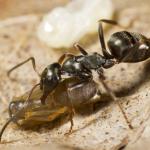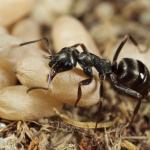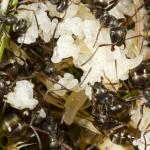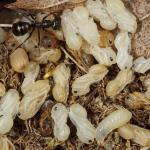This species is very similar in appearance, size (4-7 mm) and nesting habits to Formica fusca, but was firmly described and keyed by Yarrow in I954. Workers differ from those of F. fusca by the presence of short stubby hairs on the promesonotal dorsum which is usually bare in F. fusca, and there are good diagnostic differences in males and queens (Skinner & A llen 1990).
Editor's note. The original profile combined the two species F. fusca and F. lemani but this has been split by the editor to follow the Atlas style.
Formica lemani is abundant on high moorland in south-west England - Bodmin, Dartmoor, Exmoor, Mendips and Blackdown and on uncultivated land throughout Wales, northern England and Scotland as far as Hoy in Orkney. Excepting a doubtful record from Horsell Common, Surrey, it appears to be absent from the counties of south-east England - Hampshire and the Isle of Wight to Kent, Bedford and Northampton. Occasionally F. fusca and F. lemani have been found in close juxtaposition in the same habitat, but although dorsal hairs are sometimes sparse in a few worker samples, no true hybrids have been recognised.
Not listed in Shirt ( 1987) or by Falk ( 1991). There is no decline in this species which continues to do well in its known locations.
Nests are sited in open woodland, woodland verges, heaths and moorland.
Winged queens and males appear in July and August. Individuals disperse from the parent nest sporadically and mating occurs on the ground. New nests are started by individual queens.
The ants nest under stones and in tree stumps under loose bark, but F. lemani may sometimes nest in turfy banks. F. lemani usually has a number of queens in a nest and on favourable sites may develop a large population of interconnected nests. Individual established nests may have up to a thousand workers.
Workers forage individually. They are predators on other insects. In Yorkshire an experiment on biological control of bracken was ruined by F. lemani workers destroying an introduced population of bracken-feeding caterpillars! This species also seeks out aphid honey dew.
This species is subject to raiding by Formica sanguinea in localities where that species occurs. Commensal insects are similar to those found with F. fusca. F. lemani in some areas is parasitised by Microdon flies, and in north Europe is sometimes found with F. lugubris queens and workers. F. lemani are also known to accept F. exsecta queens in Britain.
2005





